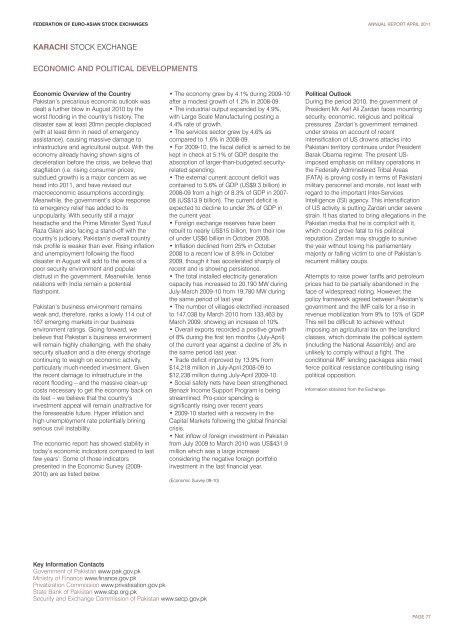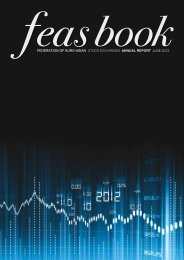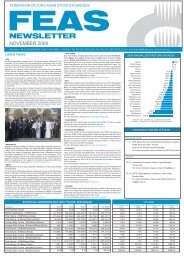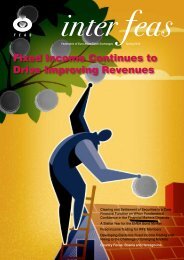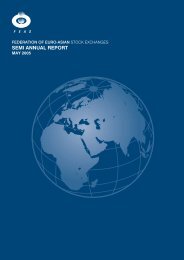Download - FEAS
Download - FEAS
Download - FEAS
You also want an ePaper? Increase the reach of your titles
YUMPU automatically turns print PDFs into web optimized ePapers that Google loves.
FEDERATION OF EURO-ASIAN STOCK EXCHANGES ANNUAL REPORT APRIL 2011<br />
KARACHI STOCK EXCHANGE<br />
ECONOMIC AND POLITICAL DEVELOPMENTS<br />
Economic Overview of the Country<br />
Pakistan’s precarious economic outlook was<br />
dealt a further blow in August 2010 by the<br />
worst flooding in the country’s history. The<br />
disaster saw at least 20mn people displaced<br />
(with at least 6mn in need of emergency<br />
assistance), causing massive damage to<br />
infrastructure and agricultural output. With the<br />
economy already having shown signs of<br />
deceleration before the crisis, we believe that<br />
stagflation (i.e. rising consumer prices,<br />
subdued growth) is a major concern as we<br />
head into 2011, and have revised our<br />
macroeconomic assumptions accordingly.<br />
Meanwhile, the government’s slow response<br />
to emergency relief has added to its<br />
unpopularity. With security still a major<br />
headache and the Prime Minister Syed Yusuf<br />
Raza Gilani also facing a stand-off with the<br />
country’s judiciary, Pakistan’s overall country<br />
risk profile is weaker than ever. Rising inflation<br />
and unemployment following the flood<br />
disaster in August will add to the woes of a<br />
poor security environment and popular<br />
distrust in the government. Meanwhile, tense<br />
relations with India remain a potential<br />
flashpoint.<br />
Pakistan’s business environment remains<br />
weak and, therefore, ranks a lowly 114 out of<br />
167 emerging markets in our business<br />
environment ratings. Going forward, we<br />
believe that Pakistan’s business environment<br />
will remain highly challenging, with the shaky<br />
security situation and a dire energy shortage<br />
continuing to weigh on economic activity,<br />
particularly much-needed investment. Given<br />
the recent damage to infrastructure in the<br />
recent flooding – and the massive clean-up<br />
costs necessary to get the economy back on<br />
its feet – we believe that the country’s<br />
investment appeal will remain unattractive for<br />
the foreseeable future. Hyper inflation and<br />
high unemployment rate potentially brining<br />
serious civil instability.<br />
The economic report has showed stability in<br />
today’s economic indicators compared to last<br />
few years’. Some of those indicators<br />
presented in the Economic Survey (2009-<br />
2010) are as listed below.<br />
• The economy grew by 4.1% during 2009-10<br />
after a modest growth of 1.2% in 2008-09.<br />
• The industrial output expanded by 4.9%,<br />
with Large Scale Manufacturing posting a<br />
4.4% rate of growth.<br />
• The services sector grew by 4.6% as<br />
compared to 1.6% in 2008-09.<br />
• For 2009-10, the fiscal deficit is aimed to be<br />
kept in check at 5.1% of GDP, despite the<br />
absorption of larger-than-budgeted securityrelated<br />
spending.<br />
• The external current account deficit was<br />
contained to 5.6% of GDP (US$9.3 billion) in<br />
2008-09 from a high of 8.3% of GDP in 2007-<br />
08 (US$13.9 billion). The current deficit is<br />
expected to decline to under 3% of GDP in<br />
the current year.<br />
• Foreign exchange reserves have been<br />
rebuilt to nearly US$15 billion, from their low<br />
of under US$6 billion in October 2008.<br />
• Inflation declined from 25% in October<br />
2008 to a recent low of 8.9% in October<br />
2009, though it has accelerated sharply of<br />
recent and is showing persistence.<br />
• The total installed electricity generation<br />
capacity has increased to 20,190 MW during<br />
July-March 2009-10 from 19,780 MW during<br />
the same period of last year<br />
• The number of villages electrified increased<br />
to 147,038 by March 2010 from 133,463 by<br />
March 2009, showing an increase of 10%.<br />
• Overall exports recorded a positive growth<br />
of 8% during the first ten months (July-April)<br />
of the current year against a decline of 3% in<br />
the same period last year.<br />
• Trade deficit improved by 13.9% from<br />
$14,218 million in July-April 2008-09 to<br />
$12,238 million during July-April 2009-10.<br />
• Social safety nets have been strengthened.<br />
Benazir Income Support Program is being<br />
streamlined. Pro-poor spending is<br />
significantly rising over recent years<br />
• 2009-10 started with a recovery in the<br />
Capital Markets following the global financial<br />
crisis.<br />
• Net inflow of foreign investment in Pakistan<br />
from July 2009 to March 2010 was US$431.9<br />
million which was a large increase<br />
considering the negative foreign portfolio<br />
investment in the last financial year.<br />
(Economic Survey 09-10)<br />
Political Outlook<br />
During the period 2010, the government of<br />
President Mr. Asif Ali Zardari faces mounting<br />
security, economic, religious and political<br />
pressures. Zardari’s government remained<br />
under stress on account of recent<br />
intensification of US drowns attacks into<br />
Pakistani territory continues under President<br />
Barak Obama regime. The present USimposed<br />
emphasis on military operations in<br />
the Federally Administered Tribal Areas<br />
(FATA) is proving costly in terms of Pakistani<br />
military personnel and morale, not least with<br />
regard to the important Inter-Services<br />
Intelligence (ISI) agency. This intensification<br />
of US activity is putting Zardari under severe<br />
strain. It has started to bring allegations in the<br />
Pakistan media that he is complicit with it,<br />
which could prove fatal to his political<br />
reputation. Zardari may struggle to survive<br />
the year without losing his parliamentary<br />
majority or falling victim to one of Pakistan’s<br />
recurrent military coups.<br />
Attempts to raise power tariffs and petroleum<br />
prices had to be partially abandoned in the<br />
face of widespread rioting. However, the<br />
policy framework agreed between Pakistan’s<br />
government and the IMF calls for a rise in<br />
revenue mobilization from 9% to 15% of GDP.<br />
This will be difficult to achieve without<br />
imposing an agricultural tax on the landlord<br />
classes, which dominate the political system<br />
(including the National Assembly) and are<br />
unlikely to comply without a fight. The<br />
conditional IMF lending packages also meet<br />
fierce political resistance contributing rising<br />
political opposition.<br />
Information obtained from the Exchange.<br />
Key Information Contacts<br />
Government of Pakistan www.pak.gov.pk<br />
Ministry of Finance www.finance.gov.pk<br />
Privatization Commission www.privatisation.gov.pk<br />
State Bank of Pakistan www.sbp.org.pk<br />
Security and Exchange Commission of Pakistan www.secp.gov.pk<br />
PAGE 77


